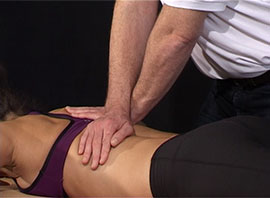The McKenzie Method
The McKenzie Method® - an Overview
The McKenzie Method® of Mechanical Diagnosis and Therapy® (MDT) is an evidence based assessment and management protocol for patients with spinal and extremity problems1-4. Mechanical Diagnosis and Therapy® has been shown to be a reliable assessment system to categorise patients into mechanical sub – groups5.
The MDT assessment enables clinicians to triage patients accurately and efficiently, particularly those with pain of spinal origin, to the appropriate services required. The assessment also identifies non-mechanical pain or contra indications to therapy where immediate referral onwards is necessary6. Research has shown that the majority of patients with mechanical spinal pain respond well to specific exercises and experience fewer symptoms when treated with exercises individualised to the patient7.
The unique combination of postural advice, and the application of specific individualised exercises when delivered by an MDT trained clinician enables patients to self-manage their condition. This process promotes patient empowerment, increases satisfaction with treatment and is also cost effective.8,9
References:
- McKenzie and May 2000, 2003, 2006,
- May and Donelson 2008,
- Chorti et al. 2009,
- Clare et al. 2004.
- May et al. 2006
- McKenzie and May 2003.
- Long et al. 2004, 2008.
- Manca et al. 2007,
- Machado et al. 2010.
Robin McKenzie on MDT Video
The Method - Step by step guide

ASSESSMENT

MDT uses a validated assessment process which enables the clinician to categorise the patient into distinct sub groups of mechanical pain. In the MDT classification system, there are 3 sub-groups or syndromes. The evaluation allows the clinician to classify patients with similar mechanical presentations into these well-defined sub-groups, which determines the appropriate management or treatment strategy.
Briefly, the Derangement Syndrome involves mechanical obstruction to movement within the joint. Dysfunction Syndrome involves pain caused by the mechanical loading of structurally impaired soft tissues and in Postural Syndrome pain develops from prolonged overloading of tissue.
After careful questioning as to how movement and positions affect symptoms, the patient is asked to move in various directions and reports back to the clinician on the effect of these various movements. For spinal patients, rapid changes occur in 50-70% of cases (depending on how long they have had their symptoms). Pain moves from a distal to a more proximal location in response to directionally specific movements. If the appropriate movement is continued, the pain retreats to the midline of the spine. This phenomenon is called Centralisation and many peer review studies have shown that patients whose symptoms centralise have a better outcome than the non-centralisers1 2
Accompanying centralisation is a gradual increase in range of movement. This phenomenon occurs in the Derangement Syndrome, which is the most common syndrome within MDT in patients with spinal problems.
An important component of the assessment is that clinicians who are well trained in MDT are able to recognise patients with pathologies unsuitable for mechanical therapy. These patients can be immediately referred for further medical evaluation to the appropriate specialist.
References:
- Werneke et al, 1999, 2005, 2008
- May and Aina 2012

CLASSIFICATION
Patients are classified as:
- Derangement Syndrome
- Dysfunction Syndrome
- Postural Syndrome
- Other
- Specific sub-groups within Other
All classifications and sub-group Other classifications have clear-cut clinical operational definitions to allow easy identification.
Each syndrome is addressed according to its unique nature, with specific mechanical procedures, including repeated movements and sustained postures. MDT is a comprehensive classification system, and includes a smaller group of patients that cannot be classified into one of the three Syndromes, but are into the ‘Other’ Subgroup which includes serious pathologies, non-mechanical causes, true chronic pain etc.

TREATMENT
Once the patient has been classified into one of the three syndromes, appropriate treatment can be applied.
- In the Derangement Syndrome the patient moves in the direction that centralises symptoms or causes a lasting reduction in their intensity.
- In the Dysfunction syndrome, movement is applied which remodels the soft tissues.
- In Postural Syndrome, the patient adopts postures which maintain the joint in a neutral position thus avoiding prolonged end range loading of the tissues
The McKenzie approach emphasises education and active patient involvement. Patients are encouraged to treat themselves. For this reason patient generated forces are used as a first resource. Where these forces are insufficient they are supplemented by clinician generated forces, such as mobilisation

PREVENTION
Once the patient has learnt to treat themselves using specific movements and postures, the same procedures can be used to prevent recurrence. This is important because research has shown that spinal pain in particular has a tendency to recur and recurrences often occur with increased severity. Preventing recurrence is therefore more important than supplying short term relief through passive treatment.